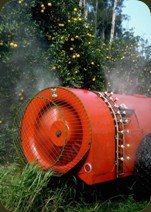Foliar fertilization

Foliar fertilization - a new dimension in fertility management - is a primary component of the Sustainable Citrus Program (SCP) developed by FLARES. Foliar fertilization is the application of small amounts of selected fertilizers to plant’s foliage for assimilation and use by the plant as a source of nutrients.
Foliar fertilization:
- Increases fruit yield
- Helps to preserve Florida’s water quality via reduced runoff
- Shows biopesticidal activity
FLARES has demonstrated the effectiveness and benefits of foliar fertilization at its research station, at Kennedy Space Center, and, on a consulting basis, at profitable commercial groves. Fertilizer selection and application technique is critical.
Fertilizers applied to the leaves are absorbed in to the leaf cells and transported throughout the plant via the phloem. This foliar uptake depends on a variety of factors investigated by FLARES, including:
- Chemical Properties of the Fertilizer Compound
- Spray Mixture Composition
- Method of Spray Application
- Crop Condition and Nutritional Status
- Growth State of Plant
- Meteorological Conditions
The Art & Science of Selecting a Foliar Fertilizer
When selecting a foliar fertilizer, FLARES considers the following factors:
- Rate of Uptake by Plant Tissue
- Solubility
- Purity - (ex. presence of Cl, biuret, heavy metals, etc.)
- Volatility
- Mobility in Plant Tissue (Translocation)
- Phytotoxicity - (Potential to Burn)
- Compatibility
- Cost
FlaRes has experimented with the following foliar fertilizations and can make custom recommendations based on site conditions:
- Chelated Micronutrients (KeyPlex® Products)
- Urea (spray grade)
- Potassium Nitrate
- Volatility
- Triazone Nitrogen (N-Sure®)
- Potassium Phosphate (0-18-20)
- Potassium Phosphonate (Phos Might®)